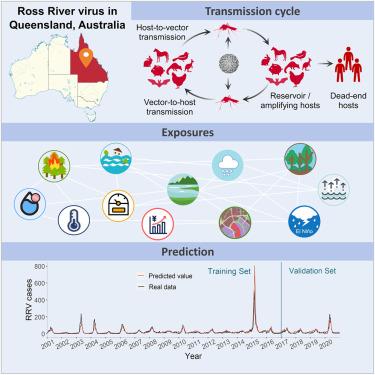解开罗斯河病毒在昆士兰的趋势:区域见解和预测建模
IF 4.1
2区 综合性期刊
Q1 MULTIDISCIPLINARY SCIENCES
引用次数: 0
摘要
罗斯河病毒(RRV)在澳大利亚昆士兰州的传播周期各不相同。确定与区域RRV发病率相关的关键暴露有助于疾病预防和控制。利用2001年至2020年的RRV报告数据,我们建立了负二项广义线性模型来预测昆士兰州三个按热气候带(热、暖、干)分类的RRV发病率。预测指标和RRV趋势在不同地区有所不同,表明独特的传播模式:炎热地区由季节性驱动,温暖地区由疫情驱动,干旱地区为混合传播模式。重要的预测因子包括最近的RRV病例、归一化植被指数(植被覆盖密度)、澳大利亚得分的可达性/偏远性指数(指示偏远性)和土地利用比例。这些发现增强了对当地RRV传播动态的理解,突出了传播的主要环境驱动因素,并为有针对性的疾病管理策略提供了信息。这种方法也可能有利于研究在不同环境和气候中具有复杂传播周期的其他病媒传播疾病。本文章由计算机程序翻译,如有差异,请以英文原文为准。

Unpacking Ross River virus trends in Queensland: Regional insights and predictive modeling
Ross River virus (RRV) transmission cycle varies across Queensland, Australia. Identifying key exposures associated with regional RRV incidence can aid disease prevention and control. Using RRV notification data from 2001 to 2020, we developed negative binomial generalized linear models to predict RRV incidence across three Queensland regions categorized by thermal climate zones (Hot, Warm, and Dry). Predictors and RRV trends differed across regions, indicating unique transmission patterns: seasonally driven in the Hot region, outbreak driven in the Warm region, and a mixed transmission pattern in the Dry region. The important predictors included recent RRV cases, normalized difference vegetation index (vegetation cover density), accessibility/remoteness index of Australia scores (indicating remoteness), and land use proportions. These findings enhance the understanding of local RRV transmission dynamics, highlight primary environmental drivers of transmission, and inform targeted disease management strategies. This approach may also benefit studies on other vector-borne diseases with complex transmission cycles in varying environments and climates.
求助全文
通过发布文献求助,成功后即可免费获取论文全文。
去求助
来源期刊

iScience
Multidisciplinary-Multidisciplinary
CiteScore
7.20
自引率
1.70%
发文量
1972
审稿时长
6 weeks
期刊介绍:
Science has many big remaining questions. To address them, we will need to work collaboratively and across disciplines. The goal of iScience is to help fuel that type of interdisciplinary thinking. iScience is a new open-access journal from Cell Press that provides a platform for original research in the life, physical, and earth sciences. The primary criterion for publication in iScience is a significant contribution to a relevant field combined with robust results and underlying methodology. The advances appearing in iScience include both fundamental and applied investigations across this interdisciplinary range of topic areas. To support transparency in scientific investigation, we are happy to consider replication studies and papers that describe negative results.
We know you want your work to be published quickly and to be widely visible within your community and beyond. With the strong international reputation of Cell Press behind it, publication in iScience will help your work garner the attention and recognition it merits. Like all Cell Press journals, iScience prioritizes rapid publication. Our editorial team pays special attention to high-quality author service and to efficient, clear-cut decisions based on the information available within the manuscript. iScience taps into the expertise across Cell Press journals and selected partners to inform our editorial decisions and help publish your science in a timely and seamless way.
 求助内容:
求助内容: 应助结果提醒方式:
应助结果提醒方式:


